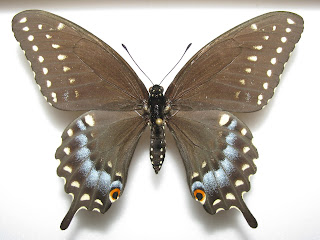For me, this has always been one of the easiest butterflies to raise, not only because they can be attracted to most home gardens, but I find the females aren't shy about laying eggs. Some butterflies, like Papilio glaucus (Eastern Tiger Swallowtail) need certain conditions to induce oviposition (egg laying), including a certain amount of sunlight, temperature, and enough space in which to fly around and find the host plant. While Papilio polyxenes asterius may not be hurt by those optimal conditions, I've found that it often doesn't need that perfect combination either. I recall fondly once when I was still in university, where I caught (by hand!) a female specimen on campus. I bought some parsley from the grocery store, and just put the butterfly on the parsley bunch and that was all it took for it to lay eggs. Over two days, it laid about 120 eggs, and I raised all of them! She probably could've laid more, but I didn't think I could handle any more after seeing what she did after just two days of egg laying, so I released her into the wild.
The eggs are spherical, about 1 mm wide, and is shown in the center of the above photo. Depending on temperature, the egg will turn dark over the course of several days, and a caterpillar will hatch. This species has five larval instars.
It's dark, with a white saddle in the middle, mimicking a small amount of bird poo. This, as you will find out, is a common theme amongst swallowtail butterfly larvae.
After about 2 days of eating, it moults into a second instar larva. It's still black with a white saddle, but you can also see tiny bumps on the larva which are surrounded by an orange/red base.
The third instar is a bit bigger, but not much changed in terms of color.
This is the fourth instar larva. It's now a nice green with black stripes that are interrupted by yellow dots. Many swallowtail larva undergo such a color change for its fourth or fifth instar, whereby they no longer mimic bird droppings, but become various patterns of green to blend in with the foliage. It still has some small black bumps all along its body.
This is a fully grown larva, the fifth and final instar. It's now totally smooth, with no bumps anywhere. When fully grown, it will be about 4.5 cm long. It gets to be a pretty decent size, but it doesn't seem to eat as much food as some other caterpillars that reach a similar size, in my experience. This guy isn't starved or malnourished at all - look at those chubby prolegs! The stripes and dots pattern help break up its outline and helps it camouflage - it's similar to the spots on a cheetah.
When it's done feeding, it will evacuate its guts with a semi-solid greenish stool, and then find a place to pupate. Like other swallowtail caterpillars, it attaches its bum to a pad of silk, and then builds a silk girdle to support its mid section.
Pupae can be either green or brown. Green pupae tend to happen in the summer, and is for blending in with green foliage. Brown pupae tend to results from larvae which develop toward the end of a growing season, and are likely to hibernate. Having said that, both color forms occur in any population and at any time, so this isn't a hard and fast rule. Certainly, brown pupae can produce adults without going into hibernation first. This pupa eventually produced a female butterfly which was released.
Going from top to bottom are two males, dorsal and ventral, and two females, dorsal and ventral. Females tend to have less yellow overall on both the upper and under surfaces, and females also have more blue coloring on the upper side of the hind wings. There are many butterflies that look similar, and it is theorized that they are all mimics of Battus philenor philenor (Pipevine Swallowtail), which is distasteful to birds. By looking similar, they may gain some protection, as birds will avoid both Battus philenor philenor and these mimics.
If you'd like to try your hand at this, just plant some parsley, and sooner or later, these butterflies will show up (if you live in an area in which they naturally occur - this information is easily obtained via the internet). If you happen to be less than successful at attracting them to your garden, at least you can enjoy fresh parsley from your garden.













No comments:
Post a Comment